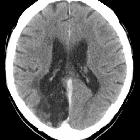Posterior cerebral artery (PCA) infarct
Posterior cerebral artery (PCA) infarcts arise, as the name says, from occlusion of the posterior cerebral artery. It is a type of posterior circulation infarction.
Clinical presentation
Symptoms of posterior cerebral artery stroke include contralateral homonymous hemianopia (due to occipital infarction), hemisensory loss (due to thalamic infarction) and hemi-body pain (usually burning in nature and due to thalamic infarction) . If bilateral, often there is reduced visual-motor coordination . It is generally considered that sensory loss and hemianopia unilaterally without paralysis, is diagnostic of PCA territory stroke .
Because the PCA supplies the thalamus, PCA infarction can lead to contralateral thalamic syndrome.
Etiology
The most common causes of PCA strokes include atherosclerosis, small artery disease and embolism .
Treatment
Depending on the timing (within 4.5 hours), patients may be eligible for thrombolysis . If they preset after this window, patients may be suitable candidates for endovascular treatments (including stenting, angioplasty, mechanical embolectomy etc) .
The size of the vessel and unclear symptoms onset can make the treatment of acute ischemic stroke challenging .
Siehe auch:
- Ischämischer Schlaganfall
- Arteria cerebri posterior
- arterielle Versorgungsgebiete des Gehirns
- Apoplex
- Infarkt hinteres Stromgebiet
- territory of the posterior cerebral arteries
und weiter:

 Assoziationen und Differentialdiagnosen zu Infarkt der Arteria cerebri posterior:
Assoziationen und Differentialdiagnosen zu Infarkt der Arteria cerebri posterior:





